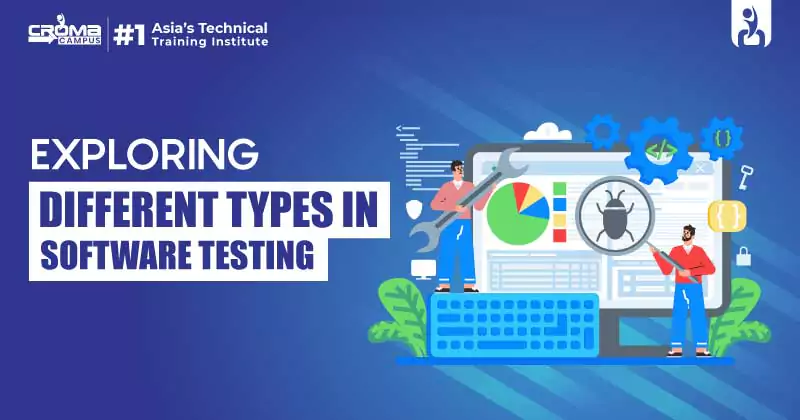Exploring Different Types In Software Testing
4.9 out of 5 based on 14526 votesLast updated on 4th Nov 2023 11.49K Views
- Bookmark

Software engineering types include application, system, and embedded. Each serves unique purposes in designing and developing software solutions.

This blog mainly covers different software testing types, from unit testing to performance and security testing, concluding with key takeaways and frequently asked questions for a holistic understanding of testing types in software engineering.
- What is Software testing?
- Types of Software Testing - Overview
- Unit Testing
- Integration Testing
- Regression Testing
- Smoke Testing
- System Testing
- Performance Testing
- Security Testing
- Stress Testing
- Recovery Testing
- Functional Testing
- Alpha Testing
- Beta Testing
- User Acceptance Test
- Key takeaways
What is Software Testing?
Software testing is like making sure a new computer program does its job without any issues. It's a crucial part of assuring that the program works well and keeps users satisfied.
In this Blog, We Will Cover:
- An in-depth exploration of different types of software testing.
- The role of each testing type in delivering high-quality software solutions.
- Insights for software developers, testers, and those curious about software testing.
- A comprehensive understanding of software testing in the software development lifecycle.
Once you go through this blog, you will get to know about different ways to make your software error-free. Also, it is important to master to make any software more valuable in the market.
Exploring the Different Types of Software Testing
Curious to know about the ways we can find and fix software errors. Let us help you out. Let us start the discussion by understanding the principles of testing first.
Principles of Testing
- Meeting Customer Requirements: All tests should align with the customer's requirements to ensure the software meets their needs.
- Third-Party Testing: To maintain objectivity, software testing is often performed by a third party.
- Optimal Testing: Exhaustive testing isn't always feasible. The level of testing should be based on a risk assessment of the application.
- Planned Testing: Tests should be well-planned before implementation to ensure thorough coverage.
- The Pareto Principle: This rule, known as the 80/20 rule, suggests that 80% of errors stem from 20% of program components.
- Incremental Testing: Start with small sections and progressively expand testing to encompass larger components.
Types of Testing
In reference to software testing, there exist ten fundamental types of testing in software engineering:
- Unit Testing
- Integration Testing
- Regression Testing
- Smoke Testing
- System Testing
- Performance Testing
- Security Testing
- Stress Testing
- Recovery Testing
- Functional Testing
- Alpha Testing
- Beta Testing
- User Acceptance Test
Moving further, we will discuss each of the software testing types in detail and understand why it is important for software development in software engineering.
You may also check Selenium Testing
Unit Testing: Ensuring the Tiny Building Blocks Work
Unit testing is like checking the small building blocks (called units) of a computer program to ensure they work correctly. Unit testing is like quality checks for small parts of a computer program, ensuring they work correctly. These tests are often automated and focus on specific bits of code, like a particular function. Unit testing is done at the start of creating software when each piece of code is tested on its own.
Advantages of Unit Testing:
- It helps find mistakes early in the process before they get too tricky or expensive to fix.
- It ensures that changes in the code don't create new issues.
- It makes the code more organized and easier to understand.
- It raises the overall quality and reliability of the software.
Please note that Unit Testing is just one part of software testing. It tests one piece or a group of connected pieces. The programmer typically does it by trying out different inputs and seeing what comes out.
Example:
- It checks if loops, methods, or functions work as they should.
- It makes sure math is done the right way.
- It confirms that things start off correctly.
Integration Testing
Integration testing is like making sure different parts of a software program play well together. It checks how these pieces interact and helps find and fix issues when they're combined.
Ways to do Integration Testing:
- Top-down: Starts with the big pieces and works down to the smaller ones.
- Bottom-up: Begin with the small pieces and add the bigger ones.
- Big-Bang: Combines all the pieces at once.
- Incremental: Puts things together in smaller groups, testing each as it's added.
Are you looking for Online Software Testing Course?
Advantages of Integration Testing:
- Helps find and fix issues when different parts of the software come together.
- Makes sure all the software's units work as they should.
- Boosts the software's reliability and stability.
Integration testing checks if all the parts in a complex system work together. It's like a piece of the overall testing puzzle, along with unit, functional, and acceptance testing. The goal is to merge tested parts into a program that follows the design. We talked about the testing methods earlier.
Example:
- Black Box Testing in Software Engineering: Focuses on what the software does without worrying about how it does it.
- White Box Testing: Digs into how the software achieves its results.
You may also know Manual Testing
Regression Testing:
Regression testing is like giving your software a check-up after you make changes. It ensures your software still works properly, without new problems, after updates or fixes.
You can do regression testing in different ways:
- Retesting: You test the entire software or just the parts you changed.
- Re-execution: It's like running the same tests again to confirm nothing broke.
- Comparison: You compare the new version with the old one to be sure it's all good.
Know More About: ISTQB Certification Cost
Why Do Regression Testing?
- It keeps your software safe from new issues.
- It makes sure your software still does its job after changes.
- It boosts your software's reliability.
Remember, regression testing is ongoing, not a one-time thing. You should keep doing it as you work on your software. Automating it can save time and resources. Having a clear plan for what to test is important.
Example:
Think of a recipe book. If you add a new recipe, you'd want to make sure the whole book still works well, right? That's what regression testing does for software. It checks if everything still works after changes.
Smoke Testing:
Smoke testing is a quick check you do to ensure your software's basic functions work fine. It is like a first look to see if there is any major issue before diving into the details.
How Smoke Testing Works:
- Start Small: You begin by testing the main features, just like a quick peek.
- Quick Checks: You see if the software can handle the basics without any big problems.
- Go/No-Go: It's like a "go/no-go" signal. If the software passes, you can continue testing in more depth.
Know More About:
Why Smoke Testing Matters:
- It catches glaring issues upfront.
- It saves time and resources by spotting major problems early.
- It ensures you're on the right track before deep-diving into testing.
Remember, smoke testing is just the first step. You'll need more detailed testing to cover everything.
Example:
Think of a car. You turn the key to check if the engine starts, you don't need to check every part. That is what smoke testing does for software – it is the first test to ensure the basics work before diving in deeper.
System Testing:
System testing checks the entire system. It ensures the software works well according to system or functional requirements. It is like making sure the car runs smoothly on different roads.
How System Testing Works:
It is like a black box, focusing on what goes in and out, not how it happens. Four common types of System Testing are Security Testing, Recovery Testing, Stress Testing, and Performance Testing. We will discuss each in brief in further sections.
Example:
It is like testing both how the car runs and how comfortable it is during a long drive.
Master efficient web testing with the Playwright Automation Course, designed to teach advanced techniques for cross-browser automation, handling dynamic content, and achieving seamless test execution for flawless web application performance.
System Testing – Security Testing
Security testing ensures that your software is like a fortress against digital threats. It shields your sensitive data, maintains trust, and avoids costly breaches.
Advantages of Security Testing:
- Protects sensitive information.
- Safeguards your reputation and customer trust.
- Prevents costly data breaches.
Example:
Consider an e-commerce website. Security testing ensures that customer payment information remains confidential, securing trust and protecting against potential cyberattacks.
System Testing – Performance Testing
Performance testing is like checking your car's engine to ensure it runs smoothly and efficiently. It ensures your software can handle various loads and performs well under different conditions.
Advantages of Performance Testing:
- Identifies software bottlenecks and areas for improvement.
- Ensures your software runs smoothly under heavy usage.
- Enhances the user experience and prevents slowdowns.
Example:
Imagine an e-commerce website on Black Friday. Performance testing ensures the site can handle a surge in users and transactions without crashing, providing a seamless shopping experience.
Note: Selenium is a powerful open-source tool for automating web applications across different browsers. Enroll in a Selenium Online Course to master its features and enhance your testing skills efficiently.
System Testing – Stress Testing
Stress testing is like pushing your car's engine to see how much it can take. It helps determine the software's breaking point under extreme conditions.
Advantages of Stress Testing:
- Reveals how the software handles extreme usage.
- Identifies vulnerabilities and potential failures.
- Ensures software reliability under pressure.
Example:
Consider a social media platform during a viral event. Stress testing ensures the platform doesn't crash or slow down when millions of users try to access it simultaneously.
System Testing – Recovery Testing
Recovery testing is like making sure your car starts again after it breaks down. It checks if the software can bounce back after a crash or failure.
Advantages of Recovery Testing:
Ensures the software can recover gracefully from failures.
Minimizes downtime and data loss.
Maintains data integrity and user confidence.
Example:
Think of an email service. Recovery testing ensures that if the server goes down, it quickly gets back online without losing your emails.
The International Software Testing Qualifications Board (ISTQB) offers globally recognized certifications, providing foundational to advanced-level knowledge and skills in software testing, and fostering professional growth.
Functional Testing
Functional testing is like taking your car for a spin to check if everything works as it should. It verifies that the software performs its functions correctly, meeting user expectations.
Ways to Perform Functional Testing:
- Unit Testing: Testing individual parts or functions.
- Integration Testing: Checking how different parts work together.
- User Acceptance Testing: Ensuring it meets user needs.
Advantages of Functional Testing:
- Confirms that the software functions as expected.
- Identifies issues that affect user experience.
- Ensures that the software meets its intended purpose.
Example:
Consider a banking application. Functional testing ensures that tasks like transferring money or checking account balances work accurately, providing users with a smooth and reliable experience.
Note: Software Testing ensures software quality and reliability through systematic evaluation. Earning a Software Testing Certification validates expertise, boosting career prospects and equipping professionals with skills to detect bugs and ensure optimal performance.
Alpha Testing
Alpha testing is like taking your car for a very first drive. It's the initial real-world test of your software in a controlled environment to uncover any glaring issues.
Advantages of Alpha Testing:
- Identifies major flaws and usability concerns.
- Allows for immediate adjustments and improvements.
- Provide feedback before releasing the software to a wider audience.
Example:
Think of a new smartphone app. Alpha testing helps find issues with the app's core functionality, like signing in or using essential features, ensuring a smoother experience for users.
Beta Testing
Beta testing is like letting a few friends test-drive your car before it hits the market. It involves real users trying your software in a real-world setting, uncovering potential issues and collecting feedback.
Advantages of Beta Testing:
- Reveals real-world problems and user opinions.
- Allows for further refinement and adjustments.
- Provides valuable insights before the software's public release.
Example:
Consider a social media platform preparing for a big launch. Beta testing lets actual users explore the platform, discover any usability or performance issues, and share feedback to improve the overall experience.
Other Related Courses:
Playwright Automation with Javascript Course
User Acceptance Testing (UAT)
User Acceptance Testing (UAT) is like a dress rehearsal before a big performance. It ensures your software not only works but also meets the needs and expectations of the end-users.
Advantages of User Acceptance Testing:
- Guarantees that the software aligns with user needs.
- Uncovers potential issues from the user's perspective.
- Builds confidence that the software is ready for release.
Example:
Imagine a new mobile app. UAT ensures that real users can navigate the app easily, find what they need and that it performs as expected. It's the last check to make sure it's user-friendly and ready to launch.
Top Trending Profiles in Software Testing
- Automation Tester
- Manual Tester
- QA Tester
- Software Testing Engineer
- Manual QA Engineer
- Functional Software Testing Engineer
Related Topic:
Software Testing Interview Questions
Software Testing Strategies in Software Engineering
Data Flow Testing in Software Testing
Key Takeaways
This blog covers various software testing types, from unit testing to user acceptance testing, offering insights into their significance and applications. It provides a comprehensive resource for software professionals and enthusiasts.
- What is Software Testing? Explore the role of software testing in ensuring program functionality and user satisfaction.
- Types of Software Testing - Overview Get an overview of testing categories.
- Unit Testing Learn how unit testing checks individual components, enhancing code quality.
- Integration Testing Understand how integration testing ensures components work together.
- Regression Testing Discover how regression testing safeguards software integrity during changes.
- Smoke Testing Find out how smoke testing quickly identifies basic function issues.
- System Testing Delve into comprehensive system testing and security, performance, stress, and recovery testing.
- Functional Testing Learn how functional testing ensures software operates as intended.
- Alpha and Beta Testing Explore the importance of alpha and beta testing in real-world software evaluation.
- User Acceptance Testing (UAT) Understand the significance of UAT in aligning software with user expectations.
This blog offers a concise yet informative guide to software testing types, catering to developers, testers, and anyone interested in this vital field.
Available Testing Courses in Delhi/NCR:
Software Testing Course in Noida
Subscribe For Free Demo
Free Demo for Corporate & Online Trainings.
Your email address will not be published. Required fields are marked *





















 Master in Cloud Computing Training
Master in Cloud Computing Training